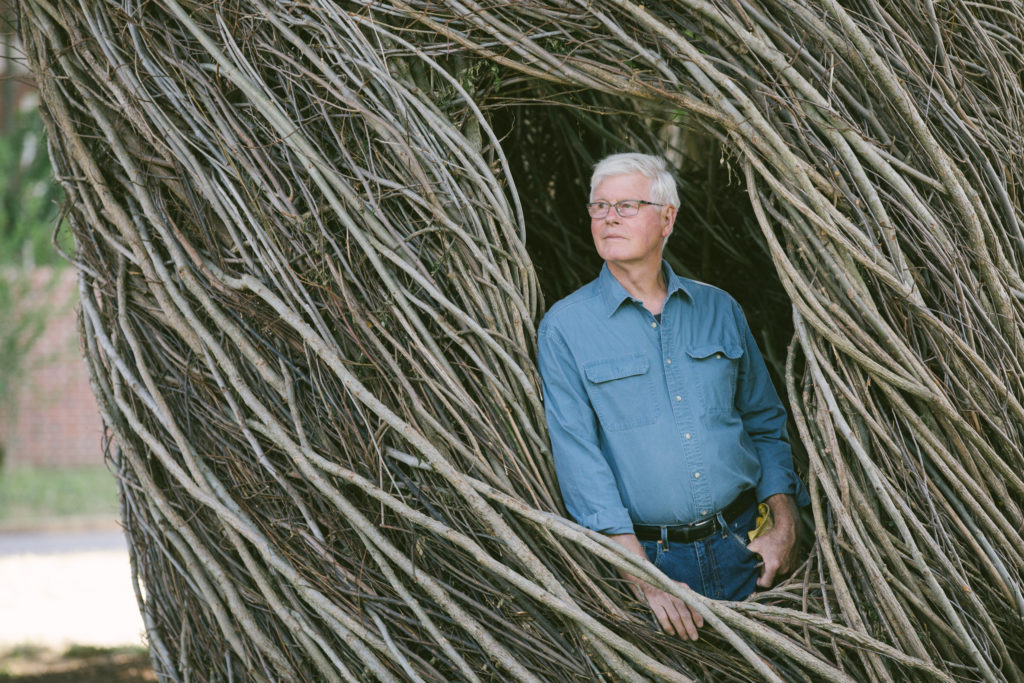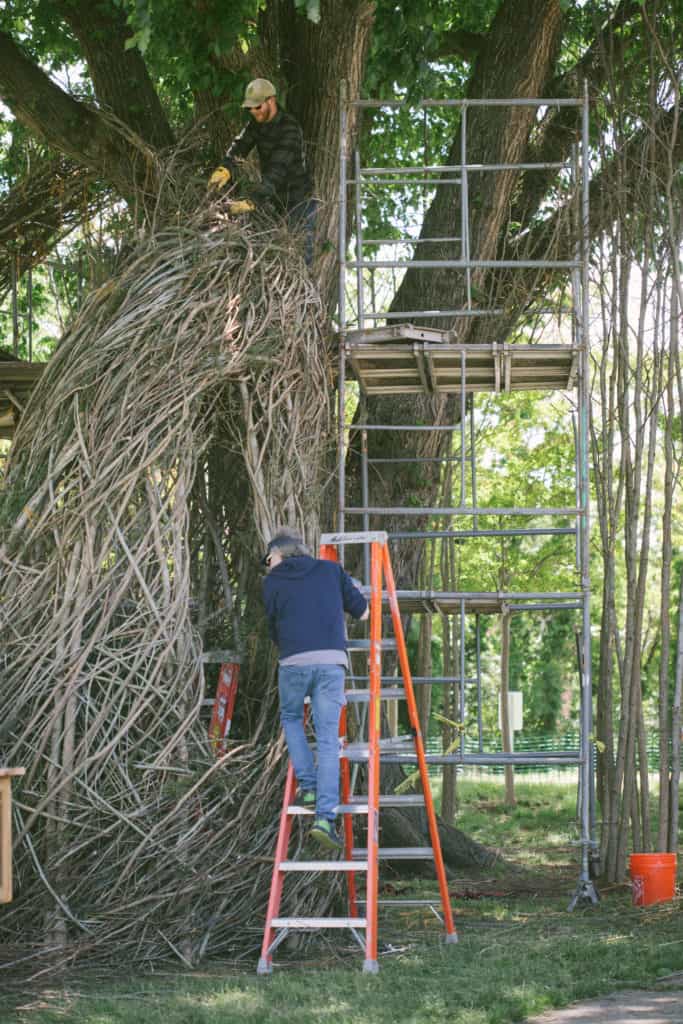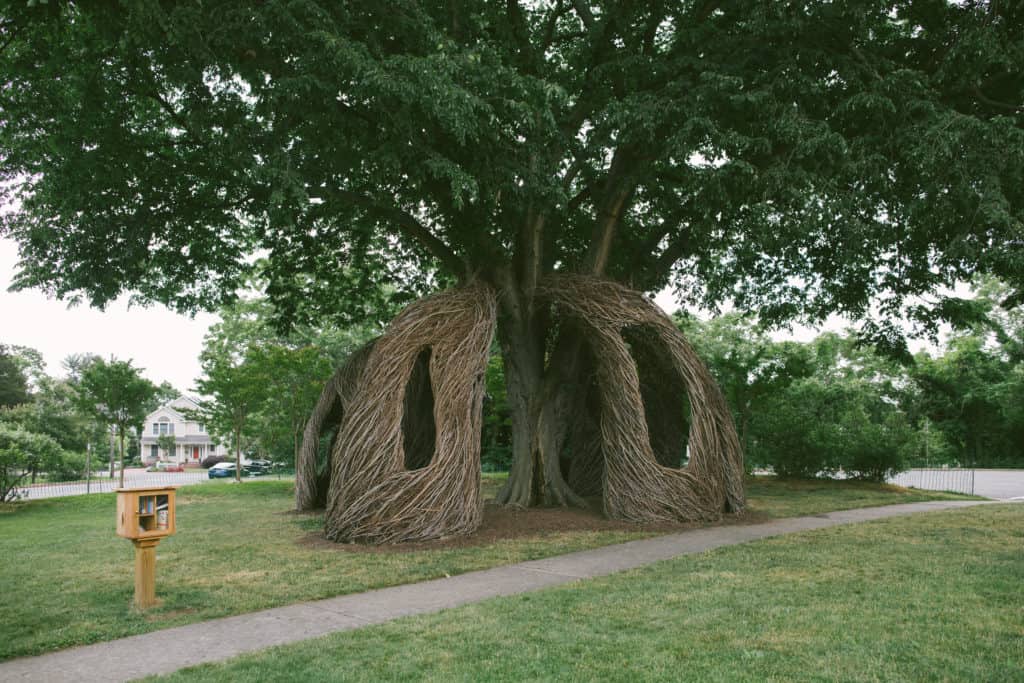From Pallet to Palette at Maryland Hall

By Keri Luise
Sticks of wood are the preferred medium of choice for renowned environmental artists Patrick Dougherty. Maryland Hall in Annapolis partnered with the artist to install a stickwork sculpture on its campus last month with help from about 150 community volunteers.
The art structure is made of cut saplings including willow, sweetgum, and sycamore from farmland and a county park on Maryland’s Eastern Shore. According to Dougherty, each sculpture he creates and installs takes three weeks to complete.
Katie Redmiles, Maryland Hall Communications Specialist, says the arts center contacted Dougherty in early 2020 “because we were embarking on a creative placemaking vision for our campus.” Dougherty was booked up until 2022 but a lucky cancellation allowed Maryland Hall to bring him in this year.
“To have the installation take place at the same time our community really started emerging from COVID and was able to reconnect in-person again was kismet and something we could never have anticipated,” Redmiles says.
Dougherty has finished 323 installations and is currently building his next one in his home state of North Carolina. He has worked all over the United States as well as in France, Italy, Korea, Japan, Sweden, Denmark and Canada.
“‘Environmental artist’ probably means different things to different people,” Dougherty says. “For me, it means using sculpture to connect people with the natural world, to remind them of their profound connection to nature so that we might live in harmony with the plants and animals that still share the earth.”
According to Dougherty, his childhood growing up in the woodlands of North Carolina, “which are overgrown with small trees and where forests are a tangle of intersecting natural lines,” shaped his choice of using tree branches and saplings as his sculpture material.
When creating his pieces, Dougherty says he first finds a supply of saplings nearby where he is working. Then, straight to the assembling.
“The actual construction technique is a layering process,” Dougherty says. “In the first phases, I pull one stick through another and build a haphazard matrix to create the rough shape of the sculpture.”

Dougherty says he then works on drawing out his plan in which he imagines “a pile of sticks as a bundle of lines with which to sketch the surface texture…In addition, I have learned to amass the smaller ends of sticks in one direction. This technique gives the impression that the surface is moving.”
The winding branches within this specific piece encircle a large 100-year-old elm tree on the grounds of Maryland Hall, creating almost a covered home under the tree. According to Dougherty, this piece, called “The Old Home Place,” resonates with him because of this interaction.
“I am reminded of the role of trees in our human activity, their sheltering of us, and the comfort we can glean from our relationship with them,” Dougherty says.
Maryland Hall reached out to the local community through e-newsletters, social media, and other communication channels in search of volunteers to help erect the structure. Redmiles says they also leaned into their partnerships with Visit Annapolis, Arts Council of Anne Arundel County, and Art in Public Places Commission Annapolis for support. They also partnered with the Green Give, a coalition of environmental groups in Anne Arundel County and the Bates Middle School Arts Integration Teachers to engage students.
“To find volunteers, we looked for people who love Maryland Hall, art, and nature,” Redmiles said. “For the volunteers who participated, they were able to get to know Patrick on a personal level. Several felt so inspired by the camaraderie of the project, they signed on to join the regular Maryland Hall volunteer corp.”
Redmiles says they have already seen students from nearby Bates Middle School sketching inside the sculpture’s woven structures.
“It is interactive and here for the public to come out and experience,” she says. “It is meant to be a shared piece of community art, accessible to all.”
But this sculpture will not stand at Maryland Hall forever.
“Once completed, my sculptures have a limited lifespan,” Dougherty says. “With branches and saplings the line between trash and treasure is very thin, and this sculpture, like the sticks it was made from, will begin to fade. Often the public imagines that a work of art should be made to last, but I believe that a sculpture, like a good flower bed, has its season. Mine are temporary sculptures with the aim of exciting the imagination of those who visit.”

